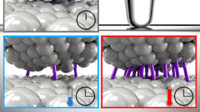
- Research
- Publication
Published:
Understanding the time evolution of contact strength in silica nanocontacts is of great fundamental and practical relevance in diverse areas like earthquake dynamics, wafer bonding mechanisms, as well as MEMS applications. The logarithmic increase of contact strength with hold time, termed contact aging, can be "quantitative" due to deformation creep in plastic contacts. An alternative mechanism, termed "qualitative aging," is the gradual change in interfacial chemistry, which so far was only observed in the presence of humidity. Here we present nanoscale friction experiments of dry silica contacts in ultrahigh vacuum that show a doubling of shear strength with time following a logarithmic law. We find that the aging rate scales linearly with temperature, and that shear stress shifts the relevant energy barriers. All-atom MD simulations provide a live picture of the bond formation dynamics occurring at the interface. Our experiments link contact aging to thermally activated bond formation, show that it exists even in the absence of water molecules, and demonstrate that this atomic aging mechanism can stretch over timescales up to several seconds. Qualitative contact aging is thus highly relevant for a broad variety of material combinations and conditions.
Publication
Matthias Vorholzer, J. G. Vilhena, Ruben Perez, Enrico Gnecco, Dirk Dietzel, André Schirmeisen: "Temperature Activates Contact Aging in Silica Nanocontacts", Phys. Rev. X 9 (2019) 041045, DOI: 10.1103/PhysRevX.9.041045External link